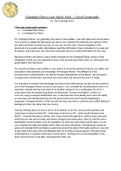Changing Places Case Study Pack - A level Geography
By eGeographyMan
This case study pack contains:
● 1x Detailed Near Place
● 1x Detailed Far Place
For Changing Places, you generally only need 2 case studies - one near place and one far place.
Your school or college will have given you two to use, however the examiner isn’t going to track
you down and find out where you live, so you can use the ones I have put together in this
document if you would prefer. Alternatively, read the information I have compiled on my near and
far places, and make your own document using this same or similar information for your own.
Because of there only being 2 case studies required for the Changing Places section of the
Geography A level, you are expected to know a fair amount about them both, so I have gone into
great detail in this document.
You should use these case studies in your exams to show the examiner that you can utilise real
examples to demonstrate your knowledge of Changing Places. The difference in the
socioeconomic characteristics, as well as the past development of the places, can be used to
compare and contrast them and show how each place has become the way it is today.
It is important to mention that knowledge you have of any other places can also be very useful to
use in the Changing Places section of your exams. I am a football fan (Southampton) and in my
real exam, despite having never been to or studied Liverpool (it is a media place for me!!), I
wrote about how the people living there use the phrase “Scouse not English”, which is a
common saying Liverpool football fans use, to describe their local identity and I went into detail
on how they have felt left behind by the UK government since the Thatcher leadership’s
supposed “managed decline” of the city and how they now have a collective and unified feeling of
belonging to their city rather than the country.
Practise thinking about an area in terms of its identity. To do this, ask yourself questions like
“what does it make me think of?”, “what does it remind me of?”, “what would it be like to live
there?”. Consider the place’s history, how it has evolved through time, what its uses were and
what they are now and crucially, why these changes have taken place. Also try and find some
quantitative numerical data, such as population, for both your near place and far place, so you
can compare this data and explain what it tells you about the places. Something as simple as
going onto Google Earth and taking a quick look around the place I find really useful as I can kind
of get a feel of the area and it will definitely help me to write an essay about it. Socioeconomic
characteristics is a golden ticket topic to write about - anything from social inequalities in the
area, local incomes or job data, unemployment rates, etc.
, Near Place - Eastleigh
Background:
Eastleigh is a “railway town”, situated in Hampshire, between Southampton and Winchester. The
town and its surrounding area is also a government district which has its own seat in the House
of Commons. As of 2018, the population of the town of Eastleigh was around 24,000 while
Eastleigh district (Eastleigh and its surrounding areas), numbered around 132,000 people.
- Eastleigh lies on the floodplain of the River Itchen - the flat relief allowed the expansion of
the town into agricultural and common land that was previously used for grazing and
growing crops. Proximity to the river also ensures there is plenty of fertile land nearby.
- Eastleigh is exceptionally well linked to other towns and cities across the UK, with it being
right next to the M27 and M3 motorways, having Eastleigh Station and Southampton
Airport Parkway Station that have links to cities such as London, Birmingham and
Southampton, and having Southampton Airport all right on its doorstep.
- Most of Eastleigh’s land is residential, with lots of house building having taken place. The
town centre is mainly used for retailing, with lots of office blocks around this area and
towards the motorway for transport links (e.g. B&Q HQ near M27 and M3). There are
also several industrial estates and business parks spaced around the town. There are 2
colleges (Eastleigh College and Barton Peveril), and multiple schools.
- Within Eastleigh there are lots of things to do. The town is home to a Vue Cinema, a
Hollywood Bowl Bowling Alley, The Point Arts Centre, Lakeside Country Park, Places
Leisure (formerly known as Fleming Park), and the Swan Shopping Centre, and there are
many shops, pubs, takeaways and other places to eat in the town centre.
- The town has a football team - Eastleigh FC, who are in the National League, the fifth tier
of English football, and play at the Silverlake stadium. Their nickname is the Spitfires,
after the famous WWII warplane that was first flown from Eastleigh in 1936.
- In 2006, Eastleigh was named the 9th best place to live in the UK on the Channel 4
programme “Best and Worst Places to Live”. The number of jobs, as well as the
excellent transport links, were cited as some of the main reasons for this.




